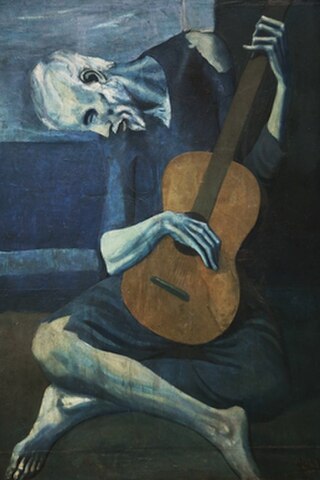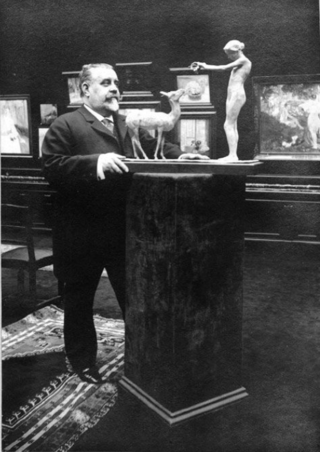
Pablo Ruiz Picasso was a Spanish painter, sculptor, printmaker, ceramicist and theatre designer who spent most of his adult life in France. One of the most influential artists of the 20th century, he is known for co-founding the Cubist movement, the invention of constructed sculpture, the co-invention of collage, and for the wide variety of styles that he helped develop and explore. Among his most famous works are the proto-Cubist Les Demoiselles d'Avignon (1907), and the anti-war painting Guernica (1937), a dramatic portrayal of the bombing of Guernica by German and Italian air forces during the Spanish Civil War.

Marie-Thérèse Walter was a French model and lover of Pablo Picasso from 1927 to about 1935 and the mother of their daughter Maya Widmaier-Picasso. Their relationship began when she was seventeen years old; he was 45 and married to his first wife, Olga Khokhlova. It ended after Picasso moved on to his next relationship, with artist Dora Maar. Walter is known as Picasso's "golden muse" and inspired numerous artworks and sculptures that he created of her during their relationship.

The Blue Period comprises the works produced by Spanish painter Pablo Picasso between 1901 and 1904. During this time, Picasso painted essentially monochromatic paintings in shades of blue and blue-green, only occasionally warmed by other colors. These sombre works, inspired by Spain and painted in Barcelona and Paris, are now some of his most popular works, although he had difficulty selling them at the time.

Ambroise Vollard was a French art dealer who is regarded as one of the most important dealers in French contemporary art at the beginning of the twentieth century. He is credited with providing exposure and emotional support to numerous then-unknown artists, including Paul Cézanne, Aristide Maillol, Pierre-Auguste Renoir, Louis Valtat, Pablo Picasso, André Derain, Georges Rouault, Paul Gauguin, and Vincent van Gogh.

Georges Petit was a French art dealer, a key figure in the Paris art world and an important promoter and cultivator of Impressionist artists.

The Dream and Lie of Franco is a series of two sheets of prints, comprising 18 individual images, and an accompanying prose poem, by Pablo Picasso produced in 1937. The sheets each contain nine images arranged in a 3x3 grid. The first 14, in etching and aquatint, are dated 8 January 1937. The remaining four images were added to the second printing plate later, without use of aquatint, and dated June 7, 1937.
Minotaur Kneeling over Sleeping Girl is a 1933 etching by Pablo Picasso. It is part of the Vollard Suite of 100 etchings. It is the first example among several works to be realized through the remaining part of the decade where Picasso used the theme of the legendary Minoan creature, the Minotaur.
Minotauromachy is a 19.5 by 27.4” etching and engraving created by Spanish artist Pablo Picasso in Paris in 1935. The etching and resulting prints, literally entitled Minotaur Battle, feature many compositional aspects and themes seen often in Picasso’s art throughout the 1930s. These include the Minotaur, an unconscious or dying female matador on an injured horse, a young girl holding a candle and flowers, a man scaling a ladder, and two women watching with doves from a window. Created during a time of personal turmoil within which Picasso created little artwork, Minotauromachy stands out as a seminal and striking piece with no shortage of artistic interpretations.

Aldo Crommelynck was a Belgian master printmaker who made intaglio prints in collaboration with many important European and American artists of the 20th century. At the time of his death, The Guardian termed Crommelynck the 'pre-eminent' and 'the most celebrated printmaker of the second half of the 20th century.'

Pierre Risch, born in 1943 in Paris, is a painter, engraver, lithographer, sculptor, and French designer.

The Blue Guitar is a suite of twenty etchings with aquatint by David Hockney, drawn in 1976–77 and published in 1977 in London and New York by Petersburg Press.

Diana Widmaier Picasso is a French art historian specialized in modern art, living in Paris.
Woman Ironing is a 1904 oil painting by Pablo Picasso that was completed during the artist's Blue Period (1901—1904). This evocative image, painted in neutral tones of blue and gray, depicts an emaciated woman with hollowed eyes, sunken cheeks, and bent form, as she presses down on an iron with all her will. A recurrent subject matter for Picasso during this time is the desolation of social outsiders. This painting, as the rest of his works of the Blue Period, is inspired by his life in Spain but was painted in Paris.

Famille d'acrobates avec singe is a 1905 painting by Pablo Picasso. It depicts a family of travelling circus performers during an intimate moment. The work was produced on cardboard using mixed media: gouache, watercolour, pastel and Indian ink. It is held by the Gothenburg Museum of Art in Gothenburg, Sweden. The work was painted at a key phase in Picasso's life, as he made the transition from an impoverished bohemian at the start of 1905 to a successful artist by the end of 1906.

Portrait of Ambroise Vollard is an oil-on-canvas painting by Pablo Picasso, which he painted in 1910. It is now housed in the Pushkin Museum in Moscow. The painting is a representation of the influential art dealer Ambroise Vollard, who played an important role in Picasso's early career as an artist. It is painted in the style of Analytical Cubism, which Picasso pioneered.
Merrill Chase Galleries was an art dealership in Chicago, Illinois. It was started in 1964 by Robert Merrill Chase Sr., and his father, Merrill Chase. By 1978 it had more than 150 employees and 13 galleries, and was among the largest organizations of its kind in the United States.

Twentieth-century art underwent a profound transformation: in a more materialist, more consumerist society, art was directed to the senses, not to the intellect. The avant-garde movements arose, which sought to integrate art into society through a greater interrelation between artist and spectator, since it is the latter who interprets the work, being able to discover meanings that the artist did not even know.
Château de Boisgeloup is an 18th-century château near Gisors in Eure, Normandy, formerly owned by Pablo Picasso and now a private art gallery run by his grandson Bernard Ruiz-Picasso and gallerist Almine Rech.













